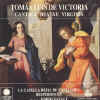Texte paru dans: / Appeared in: |
|
|
Reviewer: J.
F. Weber In discussing the eleven little pieces on this program, the notes begin by referring to the composer's forty-four motets, the most famous of his works during his lifetime. In fact only seven of these pieces belong in that discussion, the rest being two antiphons, a canticle, and the little Ave Maria. The last named and O magnum mysterium are the most familiar of these selections on records, while the two pieces for double choir are the longest and most impressive of the group. Three pieces were included in Telefunken's El Siglo de Oro album, Salve Regina, Sancta Maria, and Senex puerum, the last performed instrumentally here. Ne timeas has been recorded several times, but the rest are quite unknown to me. Half of these pieces are performed here with instrumental accompaniment. I would not have expected the equivalent of Hespèrion XX to be sitting in a choir loft during Mass or Office, nor can I think of an occasion when this music would be performed outside of church. Even so, the result is quite effective, and I credit Savall for knowing what he's doing. The sound captured in the Romanesque church in Cardona is obviously pleasing to Savall and his producer, the warmth of the acoustic not detracting from presence and clarity. The notes are helpful and texts are printed with translations. This disc fills out our impression of Victoria created by his more elaborate compositions. If you buy it, we may get a further installment. | |
|
|
|
|
|
|
|
Cliquez l'un ou l'autre
bouton pour découvrir bien d'autres critiques de CD |
|




